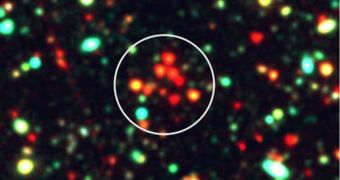A team of astronomers from the United States finally found a missing link of sorts, connecting two common types of galaxies on the evolutionary scale. Thus far, this link had not been observed anywhere in the Universe, and that called several scientific theories into question.
At this point, experts acknowledge the existence of two major types of galaxies, one made up of objects that continue to form stars, and are filled with hydrogen, and another that is completely gas-free, and also has a reddish color.
The second group of galaxies are called “red and dead,” experts say. Thus far, investigators failed to discover any galaxy that would be located somewhere between these two groups in evolution.
But this is precisely what astronomers at the University of California in Berkeley (UCB) manged to do recently, when they conducted a new study on the “early-type” galaxy called NGC 1266.
Though this object has been known for many years, astronomers still observe it from time to time, and this instance proved to be one which allowed for a major breakthrough. The UCB team reports that NGC 1266 is currently losing a lot of molecular gas from its central regions.
This type of event has not been monitored as it happens before, and experts are understandably very excited about it. If a galaxy loses its hydrogen gas, then it will not longer be able to produce new stars.
In all respects, after a fairly long time, it will become a red and dead galaxy, unable to host stellar nurseries within it until it crashes into another galaxy. Such galaxies only resume forming new stars if they receive additional gas from the outside.
“This is the first example of an early-type galaxy where all the molecular gas – the star-forming gas – is concentrated in the nucleus and where we have such a high-resolution picture of what's going on with the molecular gas in the core,” adds Leo Blitz.
“We see molecular gas being expelled at speeds that will allow it to escape from the galaxy and return to the intergalactic medium, and we see the reservoir of gas from which it's drawing,” he explains.
“That tells us that if things go on at the current rate, the gas will only last another 85 million more years,” says the investigator, who is a professor of astronomy at UCB.
“The best way to force all the gas to the center is to smash two galaxies into each other, which provides a way for the gas to lose its angular momentum and fall directly into the center,” explains UCB graduate student Katherine Alatalo.
“But there is no evidence that NGC 1266 is undergoing any sort of interaction like that, meaning we don't know how this gas lost that momentum,” she concludes, quoted by Daily Galaxy.

 14 DAY TRIAL //
14 DAY TRIAL //